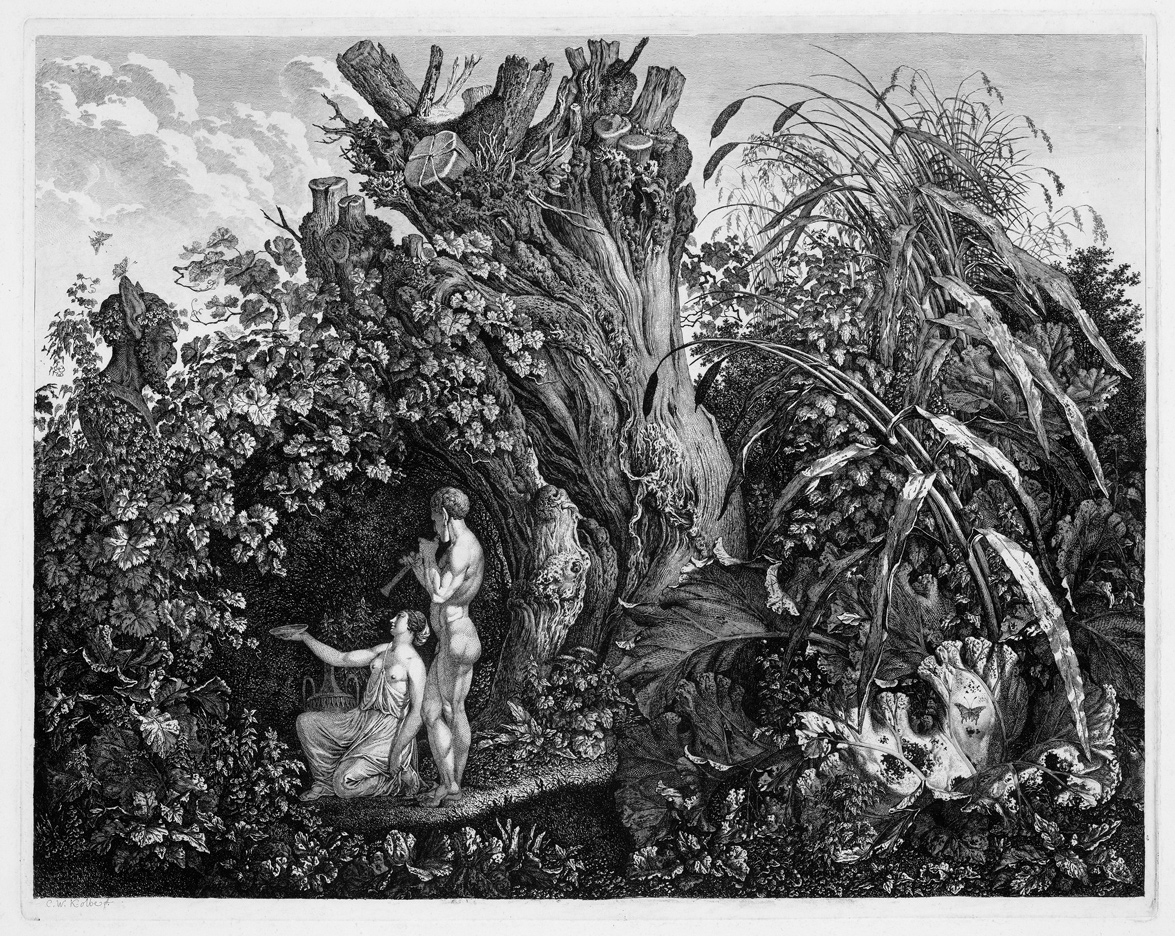Loading the page ...
Carl Wilhelm Kolbe the Elder
(1759 Berlin – 1835 Dessau)
Sacrifice to Pan. Etching on ivory-coloured wove paper. 42 x 53 cm. Circa 1808–1815. Martens 97 III.
Carl Wilhelm Kolbe’s splendid Kräuterblätter, which make up a distinct group of works within his printed oeuvre, were instrumental in establishing the artist’s fame during his lifetime. Kolbe devoted himself to this subject matter with great energy over a period of several decades after 1800. The singular elegance of these works and the love of nature they reveal put them among the finest prints made during the German Romantic period. Their most outstanding characteristic, however, is the astounding creative originality they display. The artist goes to great lengths to ensure the utmost realism and botanical accuracy. At the same time, however, he endeavours to transform what he has seen by means of outsized depictions and an abrupt foreshortening of perspectives, which enables him to create a microcosm all his own. The lush vegetation is shown from very close up, which means that – for all the minute attention to detail – it appears artistically exaggerated, not to say defamiliarized. Occasional staffage figures populate this dense, arcane undergrowth in which they appear a little lost.
The Sacrifice to Pan is one of the finest and most impressive examples of the Kräuterblätter genre. The scene, which evokes a far distant, archaic age, radiates an irresistible natural lyricism. In a concealed hiding place in this impenetrable wilderness of reeds, ivy and lush leaves a man playing a flute and a young woman in classical attire offer wine to Pan, who is almost completely entwined in the foliage. The god of the shepherds has a smirk on his face; two delicate butterflies flutter around his head. For all the pastoral harmony and the evocation of the ideas of Jean-Jacques Rousseau, there can be no overlooking the subliminal theme of transience. The finite nature of all earthly life is symbolized by the inimitably allusive quality of the dead willow stump in the centre of the picture. The rampant weeds on the ground and the lush cabbage leaves have already been eaten away by insects, thereby anticipating their inevitable withering.
Carl Wilhelm Kolbe took up art fairly late in life and worked solely as a draughtsman and etcher. He was also active as a linguist, wrote several noted philological treatises and was awarded a doctorate at the University of Halle in 1810. Kolbe began his art studies at the Berlin Academy in 1790 at the suggestion of Daniel Chodowiecki. He proved a talented student and was granted full membership of the Academy as early as 1795. The same year he settled in Dessau, since he had never felt at home in Berlin and disapproved of the cliquism among the artists there. At that time the principality of Anhalt was one of the most enlightened and progressive regions in Germany. Innumerable reforms in agriculture and the education and health systems led to economic prosperity and stimulated intellectual life in the capital Dessau. In 1798 Prince Leopold Friedrich Franz von Anhalt (1740–1817) appointed Kolbe court engraver and a teacher of art and French at the Philanthropium in Dessau. Although the position enjoyed little prestige, Kolbe proved an influential teacher who numbered the brothers Olivier and Franz Krüger among his pupils.
A superb, sharp and crisp impression with wide margins. Minor ageing and blemishes in the margins, otherwise in mint condition.
